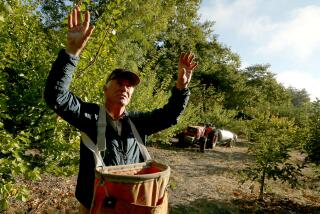Market Watch: Hothouse tomatoes from Ridgecrest, flavor included
The desolate, scrubby plain around Ridgecrest, where the Sierra Nevada meets the Great Basin and the Mojave desert, might seem an incongruous source for tomatoes, especially in the middle of winter. Nevertheless, Scott and Gale Shacklett, who go by the name of TomatoMan, manage to produce superior, flavorful tomatoes in more than half an acre of greenhouses here, where sonic booms from the China Lake Naval Air Weapons Station shatter the silence.
Open the door to their five-bay greenhouse and you are greeted by warm, humid air with a sweet, vegetal smell. Many local off-season tomato operations are hydroponic, but not this one, where carefully tended ranks of tomato plants grow from the soil up 12 feet of twine suspended from the ceiling.
The mature plants are loaded with Blitz beefsteak tomatoes and Cheresita cherry tomatoes, both bright red and glossy, a modern industrial look that may turn off heirloom aficionados. Taste the fruits, however, and they’ve got a good balance of sweetness and acidity, firm but juicy flesh and reasonably rich flavor.
Of course, they’re not as intense, complex or idiosyncratic as the best heirloom varieties, field-grown in summer. But the Shackletts’ tomatoes are as good or better than any available during their season, from January through June, and they have an attractive story behind them.
Scott, 62, was born in the area, where his father worked as a chiropractor. He met Gale at college in Chico, where he earned a degree in public administration. They married and moved to Ridgecrest, where Scott hoped to get a job in local government, but his father was a city councilman and soon became the mayor, so an anti-nepotism law put the kibosh on that plan.
As an alternative, Scott bought a landscape maintenance business and soon was mowing 130 acres of lawns a week. He segued into landscape contracting and bought a nursery in order to ensure a supply of plants.
About 1995, he and Gale put in an organic garden with a hundred tomato plants and found that the townsfolk were hungry for tomatoes that had more flavor than the ones they could get at the store.
“When the nursery opened at 9 a.m., we’d have a line of people waiting to buy our tomatoes,” recalls Gale, who worked as a registered nurse before joining her husband in the tomato business. Soon they started selling at farmers markets.
Scott built all of their greenhouses himself out of pipes, tubing and translucent polycarbonate panels, including the vents, fans, misters and irrigation system.
“It’s not that I like building greenhouses so much, but out here in the boondocks, if anything goes wrong, you’ve got to be able to fix it yourself, because you can lose your crop in an hour,” says Scott, who somewhat recalls Clint Eastwood in his lankiness and intensity.
He carefully keeps the temperature inside his greenhouses at 78 during the day and in the low 60s at night, using automated vents and fans; starting in late spring when it gets hot, he uses an evaporative cooling system that emits a foglike mist.
All of his growing practices are organic, including using organic fertilizer and not using pesticides of any kind, he says. But like many farmers he is fiercely opposed to government regulation, and so he chooses not to certify his production as organic.
Twelve years ago, the Shackletts expanded production to a greenhouse near their home in the even more remote, isolated hamlet of Onyx, a 40-minute drive west of Ridgecrest. They closed the facility three years ago, after the price of propane skyrocketed and it became too expensive to heat it.
They then leased 2½ acres in Inyokern, six miles west of Ridgecrest, and put up two greenhouses with a total of three bays. Within a year or so they plan to buy this plot, sell their land in Ridgecrest and move its greenhouse to Inyokern.
The plants in Inyokern produce roughly twice as much as in Ridgecrest, Scott explains, because the soil is less rocky, and the water, which comes from a well, has fewer minerals, such as calcium and potassium, that can cause electroconductivity, to which tomato plants are very sensitive.
“It’s a much better place for growing tomatoes,” he says.
Maintaining the proper balance of nutrients and minerals is key to tomato production and quality, he continues, adding, “The hardest thing I’ve ever done in my life is figure out how to fertilize.”
Gale sells their tomatoes — at $3.50 a pound for the beefsteaks and $4 for a basket of cherries — at the Pasadena farmers market on Saturdays, and at the Santa Monica Main Street market on Sundays. She and her husband have sold at other Southern California markets in the past but now sell at more markets in Northern California, including Davis on Saturdays and Sacramento on Sundays.
They cut back at southern markets, they say, after they were undercut by other vendors who sold tomatoes that they suspected were bought at wholesale markets. One vendor had the nerve to suggest that the Shackletts do the same.
“I can’t do that, because people will know instantly they’re not my tomatoes, because they won’t have any flavor,” says Scott. “I only want to sell tomatoes that taste the way I remember tomatoes tasting when I was a kid.”
More to Read
Eat your way across L.A.
Get our weekly Tasting Notes newsletter for reviews, news and more.
You may occasionally receive promotional content from the Los Angeles Times.






